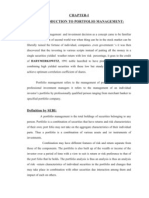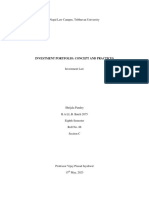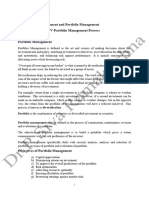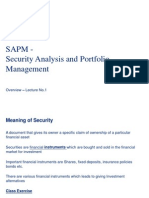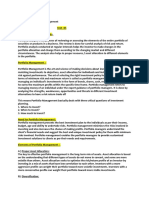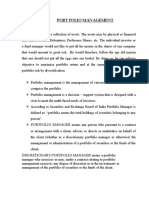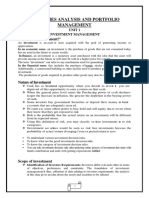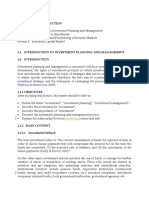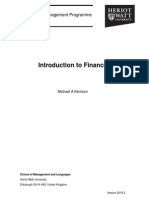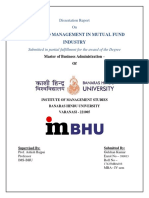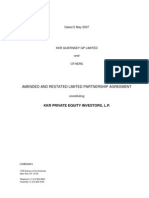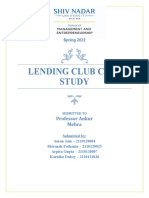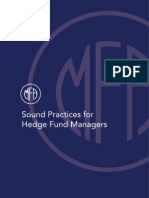Project Report On Portfolio Management
Project Report On Portfolio Management
Uploaded by
anunazanuCopyright:
Available Formats
Project Report On Portfolio Management
Project Report On Portfolio Management
Uploaded by
anunazanuOriginal Description:
Original Title
Copyright
Available Formats
Share this document
Did you find this document useful?
Is this content inappropriate?
Copyright:
Available Formats
Project Report On Portfolio Management
Project Report On Portfolio Management
Uploaded by
anunazanuCopyright:
Available Formats
Project report on portfolio management
INTRODUCTION:
The main objective of the company is to help the investors in managing their investment portfolio. The other objective is to provide best service and guideline to the clients for their suitable investment avenue, so they get maximum gain with safety for their future. Generally ,people is not aware about different safe and gainful investment avenue, if they invest their money in any investment avenue there are chances to incur a loss and could not get the proper return from it. Investors are savers but all savers cannot be good investors, as investment is a science and an art. Savings are sometimes autonomous and sometimes induced by the incentives like fiscal concessions or income or capital appreciation. Investment may be defined as the purchase by an individual or institutional investor of a financial or real asset that produces a return proportional to the risk assumed over some future investment period.
What Is Portfolio:
A portfolio is a collection of securities. Since it is rarely desirable to invest the entire funds of an individual or an institution in a single security, it is essential that every security be viewed in a portfolio context. A set or combination of securities held by investor. A portfolio comprising of different types of securities and assets. As the investors acquire different sets of assets of financial nature, such as gold, silver, real estate, buildings, insurance policies, post office certificates, NSC etc., they are making a provision for future. The risk of each of such investments is to be understood before hand. Normally the average householder keeps most of his income in cash or bank deposits and assumes that they are safe and least risky. Little does he realize that they also carry a risk with them the fear of loss or actual loss or theft and loss of real value of these assets through the rise price or inflation in the economy? Cash carries no interest or income and bank deposits carrying nominal rate of 4% on savings deposits, no interest on current account and a maximum of 9% on term deposits of one year. The liquidity on fixed deposits is poor as one has to wait for the period to maturity or take loan on such amount but at a loss of income due to penal rate. Generally risk averters invest only in banks, Post office and UTI and Mutual funds. Gold, silver real estate and chit funds are the other avenues of investment for average Householder, of middle and lower income groups.
Why Portfolio:
You will recall that expected return from individual securities carries some degree of risk. Risk was defined as the standard deviation around the expected return. In effect we equated a securitys risk with the variability of its return. More dispersion or variability about a security expected return meant the security was riskier than one with less dispersion. The simple fact that securities carry differing degrees of expected risk leads most investors to the notion of holding more than one security at a time, in an attempt to spread risks by not putting all their eggs into one basket. Diversification of ones holdings is intended to reduce risk in an economy in
which every assets returns are subject to some degree of uncertainty. Even the value of cash suffers from the inroads of inflation. Most investors hope that if they hold several assets, even if one goes bad, the others will provide some protection from an extreme loss.
Portfolio Management:
The portfolio management is growing rapidly serving broad array of investors both individual and institutional with investment portfolio ranging in asset size from few thousands to crores of rupees. In most cases, portfolio management has been practiced as a investment management counseling in which the investor has been advised to seek assets that would grow in value and / or provide income. Portfolio management is concerned with efficient management of investment in the securities. An investment is defined as the current commitment of funds for a period of time in order to derive a future flow of funds that will compensate the investing unit: - For the time the funds are committed. - For the expected rate of inflation, and - For the uncertainty involved in the future flow of funds. The portfolio management deals with the process of selection of securities from the number of opportunities available with different expected returns and carrying different levels of risk and the selection of securities is made with a view to provide the investors the maximum yield for a given level of risk or ensure minimize risk for a given level of return. Investors invest his funds in a portfolio expecting to get a good return consistent with the risk that he has to bear. The return realized from the portfolio has to be measured and the performance of the portfolio has to be evaluated. It is evident that rational investment activity involves creation of an investment portfolio. Portfolio management comprises all the processes involved in the creation and maintenance of an investment portfolio. It deals specially with security analysis, portfolio analysis, portfolio selection, portfolio revision and portfolio evaluation. Portfolio management makes use of analytical techniques of analysis
Definition of Portfolio Management:
It is a process of encompassing many activities of investment in assets and securities. The portfolio management includes the planning, supervision, timing, rationalism and conservatism in the selection of securities to meet investors objectives. It is the process of selecting listof securities that will provide the investor with a maximum yield constant with the risk he wishes to assume.
Application to portfolio Management:
Portfolio Management involves time element and time horizon. The present value of future return/cash flows by discounting is useful for share valuation and bond valuation. The investment strategy in portfolio construction should have a time horizon, say 3 to 5 year; to produce the desired results of say 20-30% return per annum. Besides portfolio management should also take into account tax benefits and investment incentives. As the returns are taken by investors net of tax payments, and there is always an element of inflation, returns net of taxation and inflation are more relevant to tax paying investors. These are called net real rates of returns, which should be more than other returns. They should encompass risk free return plus a reasonable risk premium, depending upon the risk taken, on the instruments/assets invested.
Portfolio Management is used to select a portfolio of new product development projects to achieve the following goals: Maximize the profitability or value of the portfolio Provide balance Support the strategy of the enterprise Portfolio Management is the responsibility of the senior management team of an organization or business unit.
INVESTMENT PORTFOLIO MANAGEMENT AND PORTFOLIO THEORY
Portfolio theory is an investment approach developed by University of Chicago economist Harry M. Markowitz (1927 - ), who won a Nobel Prize in economics in 1990. Portfolio theory allows investors to estimate both the expected risks and returns, as measured statistically, for their investment portfolios. Markowitz described how to combine assets into efficiently diversified portfolios. It was his position that a portfolios risk could be reduced and the expected rate of return could be improved if investments having dissimilar price movements were combined. In other words, Markowitz explained how to best assemble a diversified portfolio and proved that such a portfolio would likely do well. There are two types of Portfolio Strategies: A. Passive Portfolio Strategy A strategy that involves minimal expectation input, and instead relies on diversification to match the performance of some market index.B. Active Portfolio Strategy A strategy that uses available information and forecasting techniques to seek a better performance than a portfolio that is simply diversified broadly.
OBJECTIVES OF PORTFOLIO MANAGEMENT:
The basic objective of Portfolio Management is to maximize yield and minimize risk. The other objectives are as follows: a) Stability of Income: An investor considers stability of income from his investment. He also considers the stability of purchasing power of income. b) Capital Growth: Capital appreciation has become an important investment principle. Investors seek growth stocks which provide a very large capital appreciation by way of rights, bonus and appreciation in the market price of a share. c) Liquidity: An investment is a liquid asset. It can be converted into cash with the help of a stock exchange. Investment should be liquid as well as marketable. The portfolio should contain a planned proportion of high-grade and readily salable investment. d) Safety: safety means protection for investment against loss under reasonably variations. In order to provide safety, a careful review of economic and industry trends is necessary. In other words, errors in portfolio are unavoidable and it requires extensive diversification e) Tax Incentives: Investors try to minimize their tax liabilities from the investments. The portfolio manager has to keep a list of such investment avenues along with the return risk, profile, tax implications, yields and other returns
STEPS IN PORTFOLIO MANAGEMENT Performance:
1) IDENTIFICATION OF THE OBJECTIVES: The starting point in this process is to determine the characteristics of the various investments and then matching them with the individuals need and preferences. all the personal investing is designed in order to achieve certain objectives. These objectives may be tangible such as buying a car, house etc. and intangible objectives such as social status, security etc. Similarly, these objectives may be classified as financial or personal objectives. Financial objectives are safety, profitability and liquidity. Personal or individual objectives may be related to personal characteristics of individuals such as family commitments, status, depends, educational requirements, income, consumption and provision for retirement etc. 2) FORMULATION OF PORTFOLIO STRATEGY : The aspect of Portfolio Management is the most important element of proper portfolio investment and speculation. While planning, a careful review should be conducted about the financial situation and current capital market conditions. This will suggest a set of investment and speculation policies to be followed Thestatement of investment policies includes the portfolio objectives, strategies Constraints. Portfolio strategy means plan or policy to be followed while investing in different types of assets. There are different investment strategies. They require changes as time passes, investors wealth changes, security price change, investors knowledge expands. Therefore, the optional strategic asset allocation also changes. The strategic asset allocation policy would call for broad diversification through an indexed holding of virtually all securities in the asset class. 3) SELECTION OF ASSET MIX: The most important decision in portfolio management is selection of asset mix. It means spreading out portfolio investment into different asset classes like bonds, Stocks, mutual funds etc. In other words selection of asset mix means investing in different kinds of assets and reduces risk and volatility and maximizes returns in investment portfolio. Selection of asset mix refers to the percentage to the invested in various security Classes The security classes are simply the type of securities as under: money market Instrument fixed income security. equity shares real estate investment International securities Once the objective of the portfolio is determined the securities to be included in the Portfolio must be selected. Normally the portfolio is selected from a list of high-quality bonds that the portfolio manager has at hand.
The portfolio manager has to decide the goals before selecting the common stock. The goal may be to achieve pure growth, growth with some income or income only. Once the goal has been selected, the portfolio manager can select the common stocks. 4) PORTFOLIO EXECUTION: The process of portfolio management involves a logical set of steps common to any decision, plan, implementation and monitor. Applying this process to actual portfolios can be complex. Therefore, in the execution stage, three decisions need to be made, if the percentage holdings of various asset classes are currently different from desired holdings. The portfolio than, should be rebalanced. If the statement of investment policy requires pure investment strategy, this is only thing, which is done in the execution stage. However, many portfolio managers engage in the speculative transactions in the belief that such transactions will generate excess risk-adjusted returns. Such speculative transactions are usually classified as timing or selection decisions. Timing decisions over or under weight various asset classes, industries or economic sectors from the strategic asset allocation. Such timing decisions are known as tactical asset allocation and selection decision deals with securities within a given asset class, industry group or economic sector. The investor has to begin with periodically adjusting the asset mix to the desired mix, which is known as strategic asset allocation. Then the investor or portfolio manager can make any tactical asset allocation or security selection decision. 5) PORTFOLIO REVISION: Portfolio management would be an incomplete exercise without periodic review. The portfolio, which is once selected, has to be continuously reviewed over a period of time and if necessary revised depending on the objectives of investor. Thus, portfolio revision means changing the asset allocation of a portfolio. Investment portfolio management involves maintaining proper combination of securities, which comprise the investors portfolio in a manner that they give maximum return with minimum risk. For this purpose, investor should have continuous review and scrutiny of his investment portfolio whenever adverse conditions develop, he can dispose of the securities, which are not worth. However, the frequency of review depends upon the size of the portfolio, the sum involved, the kind of securities held and the time available to the investor. The review should include a careful examination of investment objectives, targets for portfolio performance, actual results obtained and analysis of reason for variations. The review should be followed by suitable and timely action. There are techniques of portfolio revision. Investors buy stock according to their objectives and return-risk framework. These fluctuations may be related to economic activity or due to other factors. Ideally investors should buy when prices are low and sell when prices rise to levels higher than their normal fluctuations
The investor should decide how often the portfolio should be revised. If revision occurs to often, transaction and analysis costs may be high. If revision is attempted too infrequently the benefits of timing may be foregone. The important factor to take into consideration is, thus, timing for revision of portfolio. 6) PORTFOLIO PERFORMANCE EVALUATION: Portfolio management involves maintaining a proper combination of securities, which comprise the investors portfolio in a manner that they give maximum return with minimum risk. The investor should have continues review and scrutiny of his investment portfolio. These rates of return should be based on the market value of the assets of the fund. Complete evaluation of the portfolio performance must include examining a measure of the degree of risk taken by the fund. A portfolio manager, by evaluating his own performance can identify sources of strength or weakness. It can be viewed as a feedback and control mechanism that can make the investment Management process more effective. Good performance in the past might have resulted from good luck, in which case such performance may not be expected to continue in the future. On the other hand, poor performance in the past might have been result of bad luck. Therefore, the first task in performance evaluation is to determine whether past performance was good or poor. Then the second task is to determine whether such performance was due to skill or luck Good performance in the past may have resulted from the actions of a highly skilled portfolio manager. The performance of portfolio should be measured periodically, preferably once in a month or a quarter. The performance of an individual stock should be compared with the overall Performance of the market.
You might also like
- Prada CaseDocument12 pagesPrada CaseNam Pham100% (1)
- Port Folio ManagementDocument90 pagesPort Folio Managementnaga0017100% (1)
- Unit4 SAPMDocument11 pagesUnit4 SAPMBhaskaran BalamuraliNo ratings yet
- Project Report On Portfolio ConstructionDocument37 pagesProject Report On Portfolio ConstructionMazhar Zaman75% (4)
- Nature of Business Full NotesDocument26 pagesNature of Business Full NotestijilNo ratings yet
- Investment Analysis and Portfolio Management Chapter 7Document15 pagesInvestment Analysis and Portfolio Management Chapter 7Oumer Shaffi100% (1)
- Objectives & Scope of Portfolio ManagementDocument4 pagesObjectives & Scope of Portfolio ManagementGourav BaidNo ratings yet
- Introduction To Portfolio ManagementDocument84 pagesIntroduction To Portfolio ManagementRadhika SivadiNo ratings yet
- Chapter - 1Document69 pagesChapter - 1111induNo ratings yet
- Content: Sr. No. Particulars NODocument21 pagesContent: Sr. No. Particulars NORANG2812No ratings yet
- Chapter-2 Portfolio Analysis and SelectionDocument14 pagesChapter-2 Portfolio Analysis and Selection8008 Aman GuptaNo ratings yet
- Concept and Practices of Investment PortfolioDocument6 pagesConcept and Practices of Investment PortfolioBinodNo ratings yet
- Module 6Document13 pagesModule 6ytmandar29No ratings yet
- Portfolio ManagementDocument86 pagesPortfolio ManagementSenelwa AnayaNo ratings yet
- SAPM-VDocument20 pagesSAPM-VDr.P. Siva RamakrishnaNo ratings yet
- Sapm - Fifth (5) Sem BBIDocument156 pagesSapm - Fifth (5) Sem BBIRasesh ShahNo ratings yet
- BBA Unit 5Document4 pagesBBA Unit 5gorang GehaniNo ratings yet
- The Equity PortfolioDocument6 pagesThe Equity PortfolioPete Thomas EbueNo ratings yet
- IAPM - Unit - 4 & 5 (MBA-3)Document22 pagesIAPM - Unit - 4 & 5 (MBA-3)Kelvin SavaliyaNo ratings yet
- Portfolio Mangemnt Services Draft 28-7-14Document14 pagesPortfolio Mangemnt Services Draft 28-7-14Yash GaonkarNo ratings yet
- New Word 2007 DocumentDocument30 pagesNew Word 2007 DocumentanuragNo ratings yet
- Module No. 1 Concept of InvestmentDocument36 pagesModule No. 1 Concept of InvestmentANAS MOHDNo ratings yet
- Yasir Bhai ProjectDocument71 pagesYasir Bhai ProjectFaizan Sir's TutorialsNo ratings yet
- Portfolio ManagementDocument6 pagesPortfolio ManagementNadira RumaisaNo ratings yet
- Port Folio ManagementDocument16 pagesPort Folio ManagementanjanigolchhaNo ratings yet
- Id 49 BMDocument13 pagesId 49 BMMd Majedul HaqueNo ratings yet
- Chapter 7 - Portfolio inDocument12 pagesChapter 7 - Portfolio intemedebereNo ratings yet
- Portfolio ManagmentDocument30 pagesPortfolio ManagmentMitali Amagdav100% (1)
- SAPM Full NotesDocument52 pagesSAPM Full Noteslokeshbonde7411No ratings yet
- What Is Portfolio ManagementDocument4 pagesWhat Is Portfolio Managementsakpal_smitaNo ratings yet
- Los: 40 Portfolio Management: An Overview: A Portfolio Perspective On InvestingDocument2 pagesLos: 40 Portfolio Management: An Overview: A Portfolio Perspective On InvestingArpit MaheshwariNo ratings yet
- IPM 3.11.2016 Financial Portfolio ManagementDocument9 pagesIPM 3.11.2016 Financial Portfolio Managementavinash rNo ratings yet
- Portfolio Management: Introduction ToDocument12 pagesPortfolio Management: Introduction ToPriya RanaNo ratings yet
- Introduction To The Study: Aim of Doing The ProjectDocument64 pagesIntroduction To The Study: Aim of Doing The ProjectBeing Sumit Sharma100% (1)
- Chapter 5 - Portfolio ManagementDocument5 pagesChapter 5 - Portfolio Managementvishnu sreekumarNo ratings yet
- NISM Quick Rivision 2Document49 pagesNISM Quick Rivision 2adityaanand2190No ratings yet
- V- Investment MangementDocument14 pagesV- Investment MangementJINONo ratings yet
- Portfolio Management - India BullsDocument103 pagesPortfolio Management - India BullsNarsing Rao BodduNo ratings yet
- 4 Portfolio AnalysisDocument11 pages4 Portfolio Analysissagar dafareNo ratings yet
- Portfolio Management 1,2,3 Chapter PDFDocument53 pagesPortfolio Management 1,2,3 Chapter PDFSri LekhaNo ratings yet
- Institutional Investment Management NotesDocument13 pagesInstitutional Investment Management NotesFineman TlouNo ratings yet
- Portfolio AssignmentDocument6 pagesPortfolio AssignmentfkkfoxNo ratings yet
- Securities Analysis and Portfolio Management PDFDocument64 pagesSecurities Analysis and Portfolio Management PDFShreya s shetty100% (1)
- 21BSPHH01C0084 AKSHITASK PMMFDocument4 pages21BSPHH01C0084 AKSHITASK PMMFAkshita SkNo ratings yet
- Topic 1 IPMDocument22 pagesTopic 1 IPMmeshack mbalaNo ratings yet
- Porfolio ManagementDocument89 pagesPorfolio ManagementTeddy DavisNo ratings yet
- Presentation 1Document24 pagesPresentation 1rbiswal57No ratings yet
- CapitalDocument4 pagesCapitalshikha singhNo ratings yet
- INVESTMENTDocument3 pagesINVESTMENTCaroline B CodinoNo ratings yet
- PF GFI - English - 110359Document11 pagesPF GFI - English - 110359Lets fight CancerNo ratings yet
- Letter of Transmittal: Subject: Submission of Term PaperDocument17 pagesLetter of Transmittal: Subject: Submission of Term PaperRifat HelalNo ratings yet
- Chapter 1 The Portifolio Management Process Chapte 1Document9 pagesChapter 1 The Portifolio Management Process Chapte 1Panashe MachekepfuNo ratings yet
- Investment & Portfolio ManagementDocument129 pagesInvestment & Portfolio ManagementyxnfnfyqqqNo ratings yet
- Assignment PortifolioDocument6 pagesAssignment PortifolioANGELA MSELUNo ratings yet
- Portfolio Evaluation and RevisionDocument32 pagesPortfolio Evaluation and RevisionHarshit Gandhi100% (1)
- Investment and Insurance ManagementDocument7 pagesInvestment and Insurance Managementalithasni45No ratings yet
- Investment Management NotesDocument5 pagesInvestment Management NotesMansi Kotak0% (1)
- Class Report For Investment ManagementDocument5 pagesClass Report For Investment ManagementS VasanthNo ratings yet
- Portfolio ManagementDocument15 pagesPortfolio Managementnisha.shahi076No ratings yet
- How Beginners Achieve Financial Success: A Guide to Understanding Risk and ReturnFrom EverandHow Beginners Achieve Financial Success: A Guide to Understanding Risk and ReturnNo ratings yet
- "Futureproof Your Wealth: Mastering Investing Strategies and Technology for Financial Freedom"From Everand"Futureproof Your Wealth: Mastering Investing Strategies and Technology for Financial Freedom"No ratings yet
- Jointmeeting062210 PrasadDocument5 pagesJointmeeting062210 PrasadMarketsWikiNo ratings yet
- Introduction To FinanceDocument309 pagesIntroduction To Financepawan69100% (3)
- Batch 2 SCL Cases SRC - Full TextDocument6 pagesBatch 2 SCL Cases SRC - Full TextAthena SalasNo ratings yet
- XXXXX MFDocument24 pagesXXXXX MFpratik0909No ratings yet
- Air University BS Accounting & Finance 7 Financial Modelling Assignment 5 - Cost of Equity (Van Horne)Document2 pagesAir University BS Accounting & Finance 7 Financial Modelling Assignment 5 - Cost of Equity (Van Horne)mishal zikriaNo ratings yet
- Us Real Estate Opportunity & Private Fund: The Seventh AnnualDocument20 pagesUs Real Estate Opportunity & Private Fund: The Seventh Annualapi-3762781100% (1)
- Objective Type Questions SAPMDocument15 pagesObjective Type Questions SAPMSaravananSrvn77% (31)
- Global M A Activity Latest BCG Perpsective 1569564066Document36 pagesGlobal M A Activity Latest BCG Perpsective 1569564066l0ngj0hnsilv3rNo ratings yet
- S 13, 14 & 15 - Algorithmic TradingDocument76 pagesS 13, 14 & 15 - Algorithmic TradingAninda Dutta100% (2)
- MedMen CFO Lawsuit PDFDocument48 pagesMedMen CFO Lawsuit PDFsandydocs100% (2)
- India Instant Noodles Market - Growth, Trends, and Forecasts 2018 - 2023Document106 pagesIndia Instant Noodles Market - Growth, Trends, and Forecasts 2018 - 2023Deepak Ranjan Bhola0% (1)
- Dissertation FinalDocument67 pagesDissertation Finalgulshan kumar100% (1)
- Surviving The Grand ConvulsionDocument36 pagesSurviving The Grand ConvulsionCharles K. OrtelNo ratings yet
- Initial Public Offerings An Issuers Guide 1Document105 pagesInitial Public Offerings An Issuers Guide 1Milos MilosNo ratings yet
- KKR Private Equity Investors, L.P. Limited Partnership Agreement 2-May-2007Document50 pagesKKR Private Equity Investors, L.P. Limited Partnership Agreement 2-May-2007AsiaBuyouts100% (11)
- Group 3 - Lending Club Case Study Solutions FinalDocument2 pagesGroup 3 - Lending Club Case Study Solutions FinalArpita GuptaNo ratings yet
- Assumptions of Ideal Capital MKT and Its ViolationsDocument17 pagesAssumptions of Ideal Capital MKT and Its Violationssuchitracool133% (3)
- NIRI White Paper: Guidance Practices and PreferencesDocument7 pagesNIRI White Paper: Guidance Practices and PreferencesNational Investor Relations InstituteNo ratings yet
- BMC Module 2Document2 pagesBMC Module 2Hannah YanoskiNo ratings yet
- Risk An Return2Document19 pagesRisk An Return2Nishad Al Hasan SagorNo ratings yet
- Rwanda - Energy Sector Review and Action PlanDocument108 pagesRwanda - Energy Sector Review and Action PlansidshomeNo ratings yet
- Asia Pacific UCITS Fund CommentaryDocument24 pagesAsia Pacific UCITS Fund Commentarycena1987No ratings yet
- Nivetha.V 531900782 ProjectDocument73 pagesNivetha.V 531900782 ProjectDeepuNo ratings yet
- Fund Raising PDFDocument85 pagesFund Raising PDFNicholas SalisNo ratings yet
- CL Educate Limited DRHPDocument551 pagesCL Educate Limited DRHPankurjainNo ratings yet
- Public Relations For Improving Public Perception of The Marketing Executives in The Banking Industry in NigeriaDocument8 pagesPublic Relations For Improving Public Perception of The Marketing Executives in The Banking Industry in NigeriaAlexander DeckerNo ratings yet
- Managed Fund Association's Sound Practices For Hedge Fund Managers 2007Document276 pagesManaged Fund Association's Sound Practices For Hedge Fund Managers 2007NaisscentNo ratings yet
- FMDocument2 pagesFMankitjhambNo ratings yet

